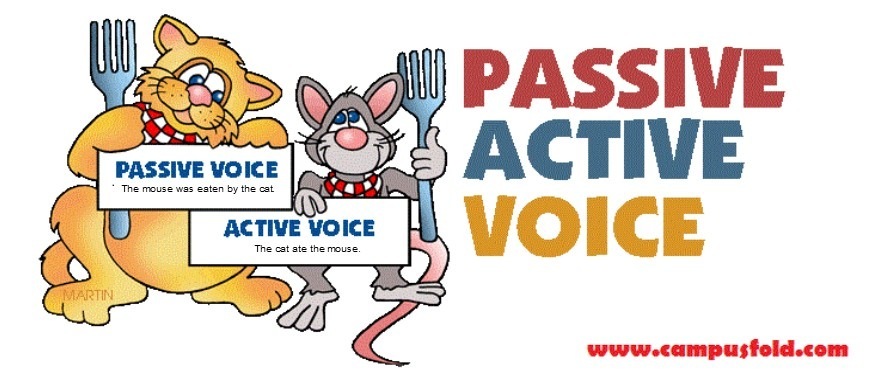Wednesday Words: Active and Passive Voice Explained -- Finally!

A reader wrote and asked if I would explain Active and Passive voice, because she has been using an electronic grammar checker and it keeps saying she should use MORE passive sentences.
Um. No. Don’t. Please.
She wasn’t completely sure what it meant, although she’s heard the term before (haven’t we all?).
The terms Active and Passive merely relate to the word order in a sentence.
If the first few words are about the actor/doer, it’s considered to be an Active Voice sentence.
If the first few words are about the results of action, it’s considered to be a Passive Voice sentence.
So, first things first:
Why should we use Active Voice in sentences? Because the sentences:
1. Focus on the actor (the being or entity that creates the action).
2. Are short and direct.
3. Are easy to understand.
4. Enhance accountability.
But the one negative about them?
5. They may not be tactful.
Why not use Passive Voice in sentences? Because the sentences:
1. Focus on the results of the action.
2. Are wordy and indirect.
3. Are sometimes hard to understand, especially when no actor is named.
4. Allow “weaseling.”
But the one positive is:
5. They allow us to be tactful.
Saying active sentences focus on the actor means that the actor is one of the first words in the sentence, often the very first. You’ll see that in the following explanations.
Saying passive sentences focus on the results means that the results are what you read about first, and later — if you’re lucky — you get to see who created the results.
But first, here are two examples of passive voice sentences:
The letter was forwarded by John.
The quarterly statements will be mailed by the end of the week.
Notice that in the first sentence, you at least DO know who forwarded the letter, right? But you have to read to the end of the sentence to find that information, and although it’s easy in a six-word sentence, it’s much tougher and tedious in a 20-word sentence.
In the second sentence, all you know is that the quarterly statements will be mailed (you know the result that is expected), but nowhere does it say by whom or by what. How is it going to happen? Magic? Doubtful.
It’s the worst kind of passive voice writing.
Here’s how to change Passive Voice to Active Voice
- Find the word “by,” which is usually near the end of the sentence.
- Use the word(s) after “by” to start your active sentence, if it makes sense (see below).
- If “by” is not written, ask yourself: “By whom or by what?” How is it going to happen? Who’s going to do it? Start your sentence with the answer.
Here are some examples to show how to change from passive voice to active voice:
1. The workshop was created by Susan.
The first one above should be easy; read until you find the person or entity that created the workshop. Start your new sentence with that name. Notice that you go from six words to four, which isn’t a huge deal, but imagine how many words you could eliminate if you changed most of your sentences from passive to active!
2. Arrangements should be made for the meeting.
Number 2, above, is tougher, because there’s no name of any sort given (really bad writing). And because of that, someday, someone is going to say, “What!?! You didn’t say I had to do it…”
Am I right?
That’s what the “weaseling” refers to above in the passive voice group. If you want accountability, use active voice. Name names. Don’t allow someone to dodge work because he or she wasn’t actually named in the sentence.
3. The reports will be analyzed and organized by next Tuesday.
Number 3 is the reason I now always say, “find the word ‘by,’ and use what follows it to start your sentence ‘if it makes sense.’ ”
Why? Because in one of my business writing classes years ago, an eager woman raised her hand, jumped to her feet, and yelled out her answer: “Next Tuesday will analyze and organize the reports!”
Let’s just say the room went silent. Dead silent. And I could only hope my face didn’t show my shock . . . it was not a pretty moment.
But she had done EXACTLY what I said to do. And I suddenly realized I had left out something vital in my instructions. Now I add “if it makes sense,” and I explain what I mean, so that no one has to be embarrassed. (No, next Tuesday cannot do something. Yes, the sentence ends with “by next Tuesday.” This is a case of a human having to read carefully and understand what’s still missing: the actor.)
Aha! Susan is going to, or the finance department is going to! Start your sentence with that person’s or department’s name, and you’ll be using the active voice.
Does this finally make sense?
The answers: #1: Susan created the workshop. 2. Kathryn (or the finance department) will arrange the meeting. 3. Susan will analyze and organize the reports by next Tuesday.
Now, as you saw at the top, I strongly believe that most of our sentences should be written in the active voice. But there are a couple of good reasons to use the passive voice as shown below.
1. When tact is important
Mistakes have been made.
Yes, you could say or write “Susan made some mistakes.” How well do you think THAT would go over with Susan (and maybe others who might wonder when their turn to be publicly shamed will come)? And while we might have to talk with Susan about what happened and find ways to keep it from happening again, doing it in public would rarely be a good move. Privately really is the best way.
There’s an old adage that speaks to this point: Praise in public. Correct in private.
2. When the actor is unknown or irrelevant
When sodium and water are combined, they burn. (Combined by whom? Who knows or cares? This reaction occurs without any help from anyone; it’s an automatic physical reaction, so there’s no real point in saying who combined them.)
The rates were set back in 2001. (By whom? Who knows or cares? Of course, if someone does know or care, the sentence should be rewritten with that information clearly stated at the beginning.)
Bonus: The cartoon at the top of the post originally read: “The mouse was eaten by the cat. The mouse ate the cat.”
Oops. Yes, the second sentence was correctly written in active voice, but . . . (I guess that’s why both the cat and the mouse are shown holding a fork!) I edited it because I liked the picture.
If this post helps you in any way, I hope you’ll find it relevant and share it with your connections.
And please leave your comments, so we can all learn from YOU.
For more articles and information on how I might be able to help you, check out my website: GrammarGoddess.com.
"
Articles from Susan 🐝 Rooks, The Grammar Goddess
View blog
I am certain every language has its own ways that might not make absolute sense in terms of spelling ...

Do you remember being a kid and wanting to grow up and know everything about everything, the way so ...

I just got a new subscription to Time magazine, something I hadn't had in years. Thanks to a friend ...
Related professionals
You may be interested in these jobs
-

Vision Associate
Found in: Lensa US 4 C2 - 22 hours ago
Walmart Acworth, United StatesWalmart Cobb Pkwy Nw - [Customer Service / Retail Associate / Team Member / from $14 to $26-hr] - As a Vision Associate at Walmart, you'll: Provide great customer service; help customers see better by helping them choose the perfect set of glasses; Answer customer questions; Assi ...
-
Part-Time Overnight Security Officer, Sat./Sun., 11PM
Found in: ZipRecruiter Test10S US C2 - 13 hours ago
Comstock Companies Reston, United States Part timeJob Description · Job DescriptionDescriptionThe Security Officer for ParkX Management ensures that the facility is run smoothly, safely, cleanly, and is a good experience for residents, tenants, and guests. · Key ResponsibilitiesComplete hourly patrol route of the property using ...
-

Registered Nurse
Found in: ZipRecruiter Test30 US C2 - 3 days ago
Trusted Health Bakersfield, United StatesJob Description · Trusted is seeking an experienced nurse for this exciting travel nursing assignment. Trusted has streamlined the travel nursing experience by enabling nurses to apply directly to jobs without the need for recruiters. This unique approach provides more transparen ...


Comments
Joyce 🐝 Bowen Brand Ambassador @ beBee
6 years ago #5
Susan 🐝 Rooks, The Grammar Goddess
6 years ago #4
Agreed, John Rylance, and in my eyes the only issue was showing others HOW to form an active voice sentence from a passive one, and that cartoon -- in its original state -- did not quite do that. Yes, it's far funnier with the mouse eating the cat. But if someone were trying to learn the way to go from passive to active . . . they might miss the idea. Thanks for your continued support of my posts here! I really appreciate it.
Susan 🐝 Rooks, The Grammar Goddess
6 years ago #3
Love that, Paul \! And I'd be delighted to collaborate on it with you!
John Rylance
6 years ago #2
Susan 🐝 Rooks, The Grammar Goddess
6 years ago #1